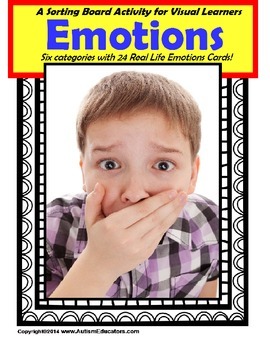Autism Emotions and Feelings Sorting Board with Real Life Pictures
- PDF
What educators are saying
Also included in
- Explore our comprehensive bundle of Special Education resources designed to support children with autism in understanding and managing their emotions and feelings. Ideal for students with autism and special learning needs, this bundle includes 12 essential tools such as reading comprehension materiaPrice $35.00Original Price $64.00Save $29.00
Description
This children's emotions and feelings sorting board activity with real life pictures helps children understand feelings and emotions with facial expressions (sad, happy, mad, scared, silly, bored). This emotions sorting activity helps teach social skills and emotions for learners with autism, pre-k, kindergarten and Special Education setting, as well as Speech Therapy for Speech and Language communication skills.
This Autism Sorting Board EMOTIONS activity comes complete with 24 Emotions Sorting Cards, two Sorting Boards (to be attached or used individually), 24 Emotions Flashcards, and two Storage Boards. Perfect for students with Autism and Special Needs, these real-life pictures will engage your students and keep them focused. A great Language activity to help students distinguish facial expressions and what they mean.
SUGGESTED IEP GOAL ALIGNMENT:
1. Given real-life pictures depicting a specific emotion, STUDENT will identify the emotion by stating or physically imitating the emotion, in 4 out of 5 consecutive opportunities, by MONTH, YEAR.
2. Given a sorting board with picture cards displaying specific emotion categories, STUDENT will place the cards in the correct categories, in 4 out of 5 consecutive opportunities, by MONTH, YEAR.
FOR MORE ACTIVITIES RELATED TO EMOTIONS, please click the link below.
Autism: Autism File Folder Activities for Emotions & Feelings
Autism Emotions Interactive Book
Autism Emotions Social Skills For Teens
For more FREE activities Go to AutismEducators. com
Please feel welcome to email me directly at: DSinger@AutismEducators.com
Let’s chat about what your students are learning, goals to be met, and the skill sets they need to succeed. We’re always here to help!
Debbie
AutismEducators.com
© Copyright 2023 Autism Educators, Inc. (AutismEducators.com). All rights reserved by author. This product is to be used by the original purchaser only. Copying for more than one teacher or classroom, or for an entire department, school, or school system is prohibited. This product may not be distributed or displayed digitally for public view, uploaded to school or district websites with the exception of distance learning for buyers sole students, distributed via email, teaching platforms such as outschool.com, or submitted to file sharing sites such as Amazon Inspire, Outschool.com or ANY sharing websites which include Facebook Sharing files. Reselling our resources without written consent, constitutes a legal violation, in which legal action will be instituted. Failure to comply is a copyright infringement and a violation of the Digital Millennium Copyright Act (DMCA). Intended for single classroom and personal use only.






